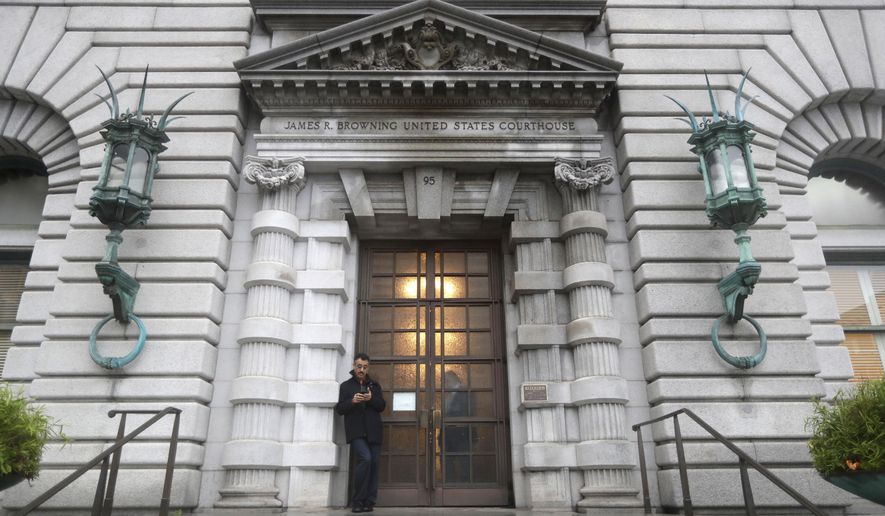The federal appeals court that covers the country’s West Coast is doing little to shake its reputation as the most out-of-touch circuit, already having notched seven cases that have been reversed by the U.S. Supreme Court so far this year and 115 over the past decade.
As the justices prepare to release final rulings in 29 cases, the U.S. Court of Appeals for the 9th Circuit again will be in the spotlight with some of its major cases, such as President Trump’s travel ban, up for review — and potential reversal — by the high court.
But as bad as the 9th Circuit’s record is, it’s losing percentage — 78 percent so far this year and 76 percent for the past decade — still isn’t the worst.
That honor goes to the U.S. Court of Appeals for the 6th Circuit, based in Ohio. Nearly 90 percent of its cases that reached the Supreme Court have been overturned in the past decade.
The 11th Circuit, based in Atlanta, is next-worst with a 78 percent reversal rate, followed by the 9th Circuit.
“The Supreme Court generally takes cases to reverse, and so you’ll notice that every circuit, by and large, has a reversal rate and some of the reversal rates are very high,” said David Vladeck, a law professor at Georgetown University.
In contrast, only 50 percent of rulings by the U.S. Court of Appeals for the 1st Circuit have been reversed in a 10-year period.
“It’s the smallest circuit in terms of workload. They don’t get a lot of the tough sort of social issues,” said Mr. Vladeck.
A Supreme Court reversal carries no real penalty other than a measure of disappointment or embarrassment, but legal scholars still track the numbers closely — and they have bled into politicking.
Mr. Trump and his allies last year pointed to the 9th Circuit’s frequent reversals after the judges on that court ruled against his travel ban policy. After several revisions, the latest version of the policy was still shot down by the 9th Circuit.
But the Supreme Court seemed to take a more open view of the ban during oral argument in April. A ruling is due by the end of June, but many legal analysts expect the 9th Circuit to add to its reversal total.
Lee Kovarsky, a law professor at the University of Maryland, said getting reversed by this Supreme Court doesn’t signal a problem for the 9th Circuit.
“The fact that they get overturned a lot by a more conservative Supreme Court doesn’t really qualify,” he said.
The 9th Circuit also sends the Supreme Court more work than any other circuit. Over the past decade, it accounted for 155 cases, nearly three times more than the next-highest caseload.
The court is huge. It covers nine Western states, including California, and several of the island territories, and has double the population of the next-largest circuit. It also receives more than 10,000 appeals a year — far more than smaller circuits.
Members of Congress, particularly those from other states in the circuit that feel swamped by California, have long pressed to break up the circuit. The Senate periodically holds hearings on the matter, including a hearing last summer.
“The sheer size of the 9th Circuit surely makes it a reasonable candidate for a split,” said Evan Young, a law professor at the University of Texas.
Mr. Evans said the last time Congress divided a circuit was in 1981, when it carved the 11th Circuit out of the 5th Circuit. At the time, he said, the 5th Circuit had less of a percentage of the nation’s population than the 9th Circuit has today.
Critics, though, claim it’s nearly impossible to fairly divide the 9th Circuit because of California’s dominance, which accounts for roughly 60 percent of the residents living in the 9th Circuit’s jurisdiction.
That means out of 29 judgeships on the circuit court, 15 of them are deemed to be held for Californians.
Sen. Jeff Flake, Arizona Republican, complained during a Senate Judiciary Committee hearing last month about the power those California judges have over his state, which has a decidedly different political and ideological temperament from California’s.
“A state with admittedly little in common with states like Arizona or Oregon or the six other remaining states in the circuit can decide the majority of appellate judges for the western half of the county,” Mr. Flake said.
Brian Fitzpatrick, a law professor at Vanderbilt University, said he also thinks the 9th Circuit should be split into smaller units.
“You can show mathematically that — everything else held equal — bigger circuits are more prone to randomly select extreme three judge panels,” he said.
One option scholars have explored is keeping California and Hawaii in the 9th Circuit and removing the other seven states. They could be made into a separate circuit or added to other circuits.
Mr. Vladeck, though, thinks the 9th Circuit is fine the way it is, and he said the heavy caseload the circuit sends to the Supreme Court is a reflection of the issues it is deciding.
“The [Supreme] Court is being very specific about what cases it takes,” he said. “It’s looking for cases it thinks are more important … in terms of effecting a large number of cases [involving] issues of social and political importance.”
• Alex Swoyer can be reached at aswoyer@washingtontimes.com.




Please read our comment policy before commenting.